“It’s about my story, isn’t it? That’s what this is all about. He didn’t want to publish my story. And we all know why—because my hero is a colored man.”
—Benny Russell, Star Trek: Deep Space Nine, “Far Beyond the Stars”“Momma! There’s a black lady on TV and she ain’t no maid!”
—Caryn Elaine Johnson, age 10, watching Star Trek in 1966, 16 years before becoming Whoopi Goldberg
Last week the producers of Amazon’s Wheel of Time television adaptation announced the cast for what can reasonably be called the show’s main protagonists, insofar as a 15-book series with over 2000 named characters and 147 unique point of view characters has main protagonists. In the books, the five characters announced today serve as the reader’s eyes for over 40% of the action, whether counting by words or by POVs. These characters matter—they are among the most famous characters in all of Western fantasy, with over 80 million copies of the Wheel of Time novels sold in the past thirty years.
Three of the five actors are of African ancestry or are Aboriginal Australian.
The announcement has sent shock waves across much of the fandom, and for an important reason: it serves as explicit rejection of an implicit promise made a very long time ago.
I.
From near infancy I have been a sci-fi fan. I gorged on Star Wars and Star Trek in my earliest memories; mandates for lightsabers and Vulcans are in my DNA right next to the bits that say I need oxygen. Fantasy took a bit longer. My first steps into fantasy as a literary genre were taken as a sixth grader alongside Lucy Pevensie, as the coats in The Wardrobe gave way to the forests of Narnia. I liked the Narnia books, some better than others. I thoroughly enjoyed The Voyage of the Dawn Treader, because the story’s main character arc is that of Eustace growing from obnoxious little bastard to a pretty decent kid; I liked The Magician’s Nephew because I love seeing competent villains struggle to do their thing when out of their element; I liked The Last Battle because I enjoy watching the hero slowly realize the imminence of the eschaton. I am not sure whether it was Lewis or me that correlated the most compelling scenes with male protagonists but the result is the same. And I knew what they looked like. They were English, and the book cover clearly showed them as white.
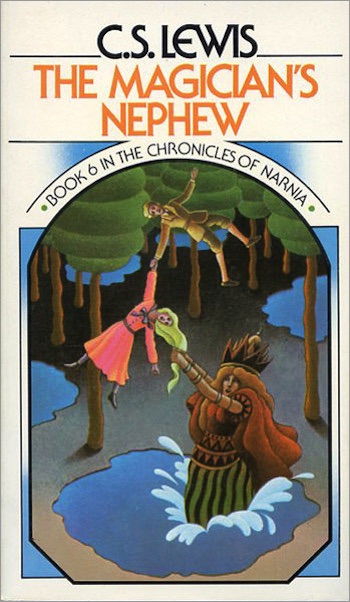
(Cover art by Roger Hane; Collier Books, 1970)
After finishing Narnia I moved on to Middle-earth, blithely unaware that Tolkien and Lewis were probably continuing some argument in a celestial pub somewhere in the afterlife. Once again, travelers from England—sorry, the Shire—went off on grand adventures, prevented the end of the world, and struggled to reintegrate back home after their quest. They were English, and they were white.

(Cover art by Michael Herring; Ballantine Books, 1983)
I was in seventh grade when I finished Lord of the Rings, and I needed some fantasy to read next. I ended up with Dragonlance, which was good enough for me, and it was well timed. I had just discovered character sheets and THAC0, and Krynn contained something neither Narnia nor Middle-earth could countenance: a main character who gets laid during the narrative.
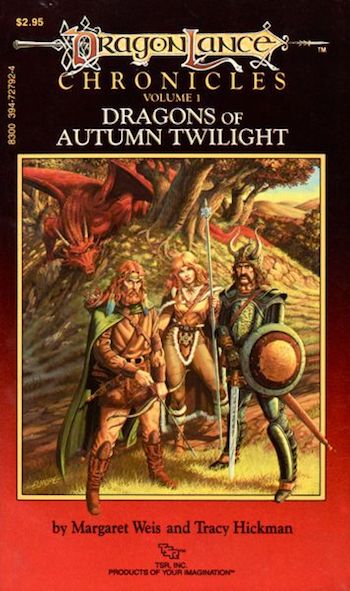
(Cover art by Larry Elmore; TSR, 1984)
Tanis, the main character, is white (you can tell; that’s him on the left, above). The barbarians are white (one is there in the center). Sturm, the warrior on the right, is white. As best I can remember, all of the relevant characters are white.
I finally finished Dragonlance after some struggle and my friend Matt (hah!) insisted I read the far superior series he was on at the time. It was longer than the other books—I knew this because Matt was reading them in class and those hardbacks were huge. And he had every book in the series. All four of them. This was 1992.
I had to catch up; the series was surely ending soon because they were coming out at a book a year and somebody at the Waldenbooks said there were only going to be six. My dad had a copy of The Eye of the World in paperback because in my lifetime Tor has never released a paperback that eluded my father’s bookshelf. The cover promised many things: a seemingly hot female wizard; a ridiculously badass warrior; other, more useless party members; and a journey. All of the essential elements were there, plus one: something about the people on that cover felt…familiar? Safe? Not weird? Not…other?
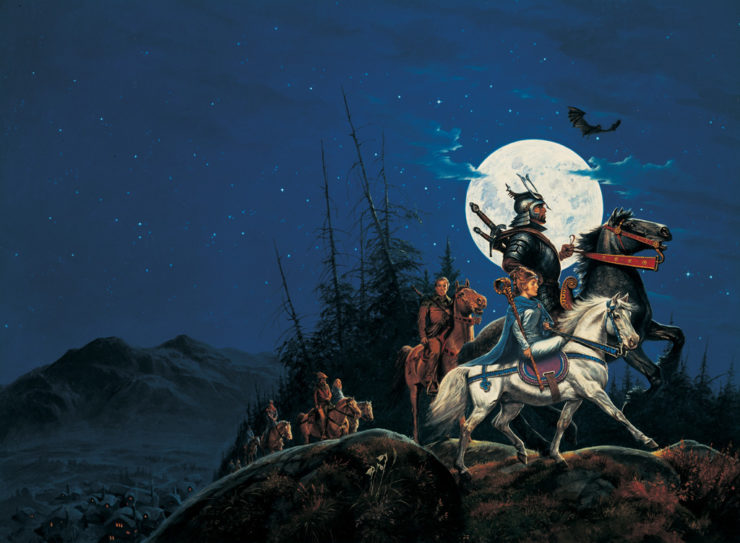
They had two arms and two legs, were clearly human, and just looked normal and not particularly worthy of comment for anything beyond what was clearly their assigned character class. Like the background noise of cicadas buzzing in the woods, incredibly loud and yet utterly unnoticed, they shared some trait—right below the threshold of perception—with Frodo, Aragorn, Gimli, Legolas, Samwise, Bilbo, a dozen dwarves, the Seven Dwarves, Willow Ufgood, every Narnian human, Captain Kirk, Mr. Spock, Luke Skywalker, Han Solo, Princess Leia, my parents, my preacher, every president ever, my teachers, all of them—all of the people who had mattered in my life at the time—all of the people who had mattered, anywhere.
Some of those works had heroic people of color in them: Lando Calrissian, Lieutenant Uhura, that one Calormene officer who comes to Aslan at the end of The Last Battle. But those works weren’t about them. Neither was this one. I knew, because the cover made that very obvious. Well, maybe not so obvious. The fighter dude up there looked kinda maybe brown, but that’s to be expected because those sorts of people are more likely to want to fight. That’s just how they are; everybody knows that. Anyway that woman was without a doubt the person really in charge here. No doubt I thought this because she is the one with a magic staff. That was, of course, the only reason my South Carolinian brain would think this. Oh look! This author lives in Charleston and went to the Citadel. How interesting.
Somewhere, a cicada buzzes.
II.
There is a doctrine in contract law called promissory estoppel. It arises when there’s a sort of agreement but no actual contract. Here’s an example: A tells B, “If you bring me 4 fantasy paperbacks from the bookstore, I will buy them from you, but don’t bring me any Piers Anthony because I cannot stand puns.” A doesn’t tell B this, but A thinks that B, a known cheapskate, will get 4 used books for a total of $10. B, seeing an opportunity, instead gets 4 paperbacks for $30 hoping to sell them to A for $40. A has sticker shock, so A refuses to pay. A and B never agreed on a price, so there’s arguably no actual contract that was ever formed. However, B did reasonably rely on A’s promise, so under the doctrine of promissory estoppel he is entitled to his costs back—just not the profit he was hoping to make, which he might be able to get under a full breach of a valid contract. A owes B $30. The purpose of promissory estoppel is to recognize that people can and do make investments when they perceive something is comfortable and low risk—even when they aren’t relying on promises presented as contracts.
There is another doctrine called course of dealing. Here’s an example: Suppose you have a good relationship with the pizzeria across the street. Every Friday night at 6 PM sharp you show up and ask for a large pepperoni and pineapple pizza. You do this for two months straight. Eventually they see you walk in and they don’t even take your order. They just ask, “the usual?” and you say “yes” and they ring you up. Another two months of this pass by, and the pizzeria now just has a pizza ready for you in a box already marked with your name on it thirty seconds before you walk in. Arguably, after 26 straight weeks of this, you and the pizzeria have a pretty solid course of dealing with each other. They know exactly what you want, and you know exactly how they’re going to give it to you. If one of you deviates from that course, the other one is likely to get upset, because their expectations have been thrown awry. Maybe not too upset, hopefully, because this is just a pizza.
What if you keep promising me the main characters are going to be white and you keep delivering that over and over and I come to trust it? What if you keep promising me that what’s on a cover matches what’s in the book? What if you don’t actually keep that promise? What if I thought I didn’t care about that, and I suddenly realize I do?
Who is the aggrieved party here? Is it me? Is it the publisher? Maybe the author?
III.
I consider myself relatively woke on racial issues and I would definitely consider myself an ally of people of color. Nevertheless, dear Reader, I saw Zoë Robins as Nynaeve and Marcus Rutherford as Perrin and I was annoyed. Not merely disappointed. Annoyed. After Rosamund Pike’s casting I had gotten my hopes up and now I saw that I had been betrayed.
I’d been had. I’d been took.
I’d been hoodwinked.
Bamboozled. Led astray. Run amok.
This is what they do. This is what these Hollywood types do; they pander and they sacrifice the art and I wish they would just change their minds and make—
What was I about to say there? What was I about to think there? I wish they would make what exactly?
Why, exactly, did I like Eustace Scrubb as a character when I was 10? Was it because he was a male or was it because he was a piece of shit who let the scales come off and become a better person? I hear the voice of Jean-Luc Picard in my head: “We think we’ve come so far. It’s all ancient history. And then, before you can blink an eye, suddenly it threatens to start all over again.” Picard again: “If we are to be damned, let us be damned for what we really are.” I am ashamed of myself and I force myself to uninterrupt the thought I’d short circuited.
I wish they would just change their minds and make them white again.
Why? Why do I care about this? It is true that I want the characters to be true to what they were on the page. So what were they on the page? I know for a fact they are white; I have read The Eye of the World probably seven times since I was a seventh grader. Where is the passage? Ah, here it is:
Elaida had put down her knitting, Rand realized, and was studying him. She rose from her stool and slowly came down from the dais to stand before him. “From the Two Rivers?” she said. She reached a hand towards his head; he pulled away from her touch, and she let her hand drop. “With that red in his hair, and gray eyes? Two Rivers people are dark of hair and eye, and they seldom have such height.” Her hand darted out to push back his coat sleeve, exposing lighter skin the sun had not reached so often. “Or such skin.”
What the hell? Two Rivers folk are at minimum darker than the untanned parts of white boys. They have dark hair and dark eyes. I flicker back to the casting photos. Yeah, ok, Zoë and Marcus definitely have dark hair; flicker; they definitely have dark eyes; flicker; their skin is darker than Josha Stradowski’s Rand; flicker; flicker flicker flicker flicker.
They pass Elaida’s test but they don’t pass my test. Why not? Not one thing in Elaida’s description says that Two Rivers folk are white. Elaida just says that Rand is an alien there and is too light to be normal there.
But it’s not just Elaida:
There were Marwins and al’Dais, al’Seens and Coles. Thanes and al’Caars and Crawes, men from every family he knew, men he did not recognize, from down to Deven Ride or up to Watch Hill or Taren Ferry, all grim-faced and burdened with pairs of bristling quivers and extra sheaves of arrows. And among them stood others, men with coppery skins, men with transparent veils across the lower half of their faces, fair-skinned men who just did not have the look of the Two Rivers.
Where did I get this idea that Two Rivers folk must be white?
I realize it immediately. It comes from two sources. As the Two Rivers themselves come from the Mountains of Mist, I realize this error has come from one source through two channels that warped my perceptions as a 12-year-old. I just never corrected it in all of this time.
First, the book covers by Darrell K. Sweet expressly and repeatedly depict the Two Rivers folk as white. Every time. All of them. Perrin may be a Wolfbrother but there is no brother to be seen on the cover of The Dragon Reborn:
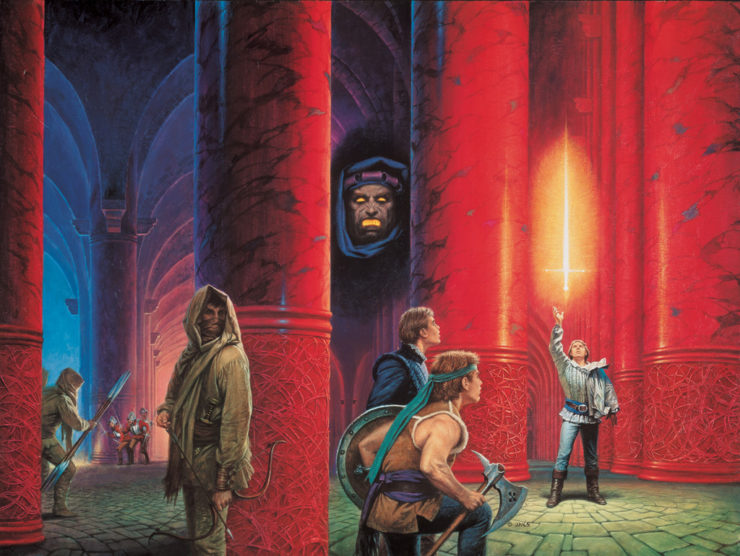
That is a Definitely Not Black dude on the cover of Winter’s Heart:
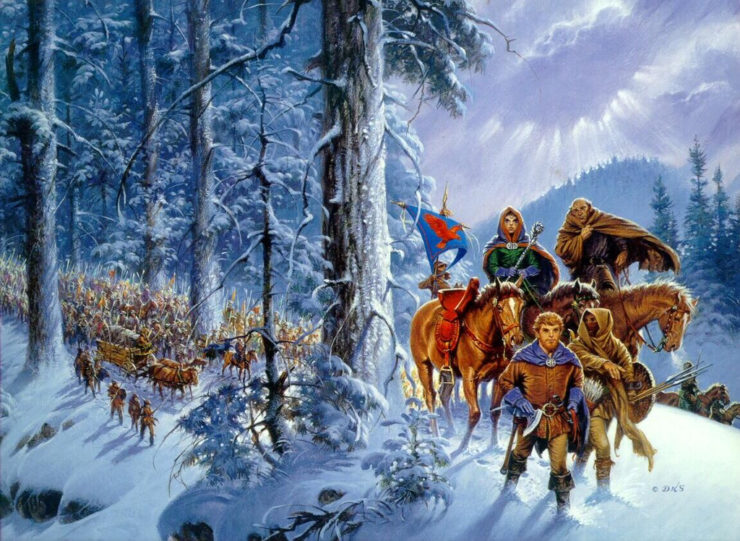
This is a council of white folk here on the cover of Knife of Dreams:
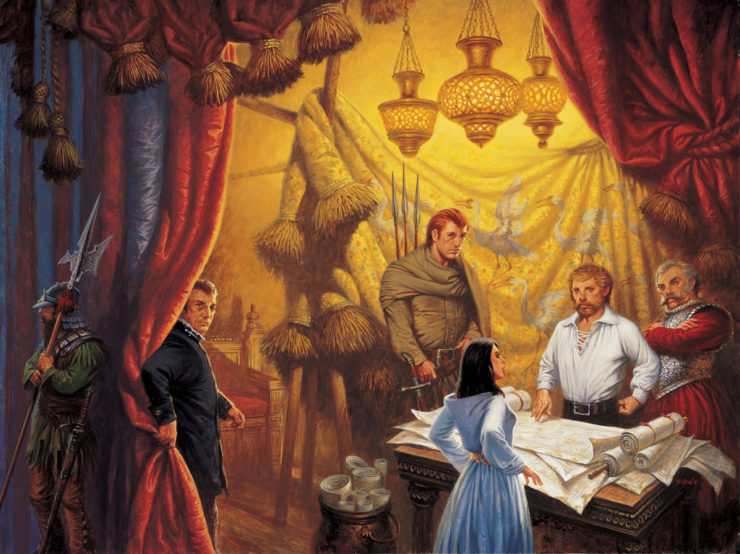
Now look at this by Raymond Swanland from the e-book for Towers of Midnight:
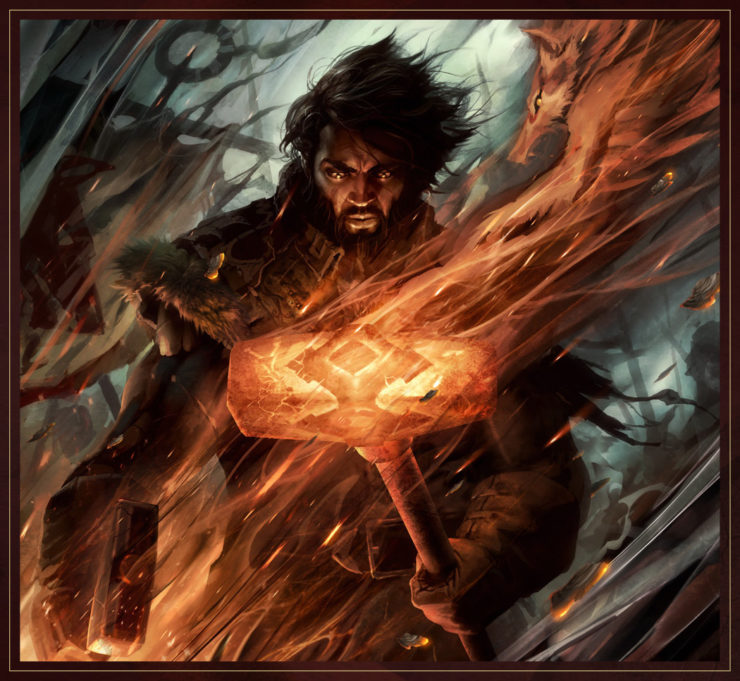
Look at that face. That face could easily be Idris Elba. Can Marcus play Swanland’s Perrin rather than Sweet’s Perrin?
“It was about a man whose family was taken from him, but who stood tall in his sorrow and protected those he could.” @Marcus_Rudda as Perrin Aybara #WoTWednesday #TwitterOfTime pic.twitter.com/4UTcqdpySA
— The Wheel Of Time (@TheWheelOfTime) August 14, 2019
Yes. End of analysis. Yes.
Now here, you should be asking “well, you say ‘Sweet’s Perrin vs. Swanland’s Perrin,’ but what really matters is can Marcus play Jordan’s Perrin?”
This goes to my second river: I envisioned the Two Rivers as white because everything before it was white. The Shire was white, Tatooine was white, my neighborhood was white. Rand views Emond’s Field as home, and my twelve-year-old self mapped a schema on top of that and said “THIS IS HIS HOME AND IT’S A QUEST STORY THEREFORE HOME MEANS THE DEFAULT AND THEREFORE LILY WHITE, THOSE ARE THE RULES, SEE THEY EVEN DO A BEL TINE DANCE WHAT COULD BE MORE WHITE THAN THAT?!” and that was pretty much the end of it. Yes, all caps is how the Dark One talks and that is exactly how this shit gets propagated—the voice enters your head from seemingly all directions and no direction all at the same time. The default is white. The default is white. The default is white. Any deviation from the default must be explained and justifiable, therefore any deviation from white must be explained and justifiable. If you don’t have a justification then you should just be white. And if you can’t be white, because you aren’t white, you need to justify yourself further.
I asked above, who is the aggrieved party when Rafe and the Awful Producers alter the deal and tell me to pray they don’t alter it further? I will tell you who the aggrieved party is.
Buy the Book
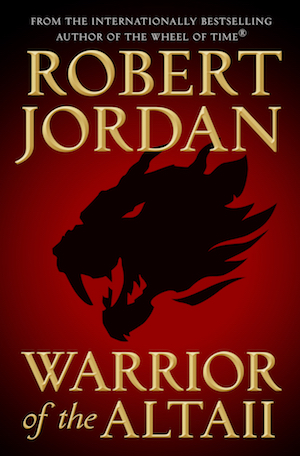

Warrior of the Altaii
The aggrieved party is every twelve-year-old black kid in my class who over the course of several months saw me tearing through my copies of the The Eye of the World, The Great Hunt, the Dragon Reborn, and The Shadow Rising which, by my count, combine in their cover art to depict a perfect record of twenty-four out of twenty-four white folks. The aggrieved party is the person who looks at fifteen consecutive book covers and says: That is a world in which people like me are not normal and have to be explained. Singing manbat vampires and armored goatpeople seem to be easily ignored elements of the milieu, but people like me don’t even exist in that world as far as I can tell.
Rafe Judkins and the producers of The Wheel of Time on Amazon have explicitly rejected the opportunity to repeat Tor’s mistake. They are openly and loudly and proudly repudiating the implied promise that we, the dear white demographic that so dominates the fantasy market, can comfortably rely on our status as the Real World default when we visit Their World.
We’re not the default on the TV show. It doesn’t matter. Yes it stings to have relied on that promise—that acquiescence—that assumption that we are the ones to be catered to by the art and the marketing and the money people for no better reason than that we are the default, and that we define ourselves as the default on the basis that we have settled on some definition of exclusion which we call “being white enough.”
In the days since the announcement I’ve seen many who try to sidestep this issue by saying they picture the Two Rivers folk as Mediterranean, and that’s light enough to count as white, while Marcus is too dark, so they object to his casting. And then they suggest instead somebody like a young Val Kilmer because Robert Jordan did once, as if this is evidence that Jordan actually cared about this issue. Yet right next to his suggestion of Kilmer as Perrin is his suggestion of Sophia Loren as Aviendha, which proves one of two things: either Jordan did not care about skin tone in his books, or he didn’t care about skin tone in a screen adaptation. Either way, the argument most heavily relied upon by the angsty fans—that this casting desecrates Jordan’s vision—has already been ruled upon and discarded by Jordan himself in his revealed preferences.
Angsty Rand finally had his moment of self-honesty on Dragonmount. Angsty white fandom should do the same. I do agree that it is bittersweet that the images I made of the characters I’ve loved for 30 years are now about to be replaced, just as Elijah Wood demolished my early mental picture of Frodo. But that’s ok. We’ve been told since day one that these images would fade into myth and eventually entirely out of memory.
The Wheel has turned. I welcome the new crew.
An earlier version of this essay appeared on Billy Todd’s personal Facebook page prior to publication on Tor.com
Billy Todd is a Starfleet officer stranded in the 21st century who escapes notice by hiding in plain sight as a corporate attorney. He further advances his cover identity by serving as the track director for the Brandon Sanderson Track at JordanCon. He occasionally violates the Temporal Prime Directive by posting on social media at Facebook and on Twitter @Billy_Todd.









